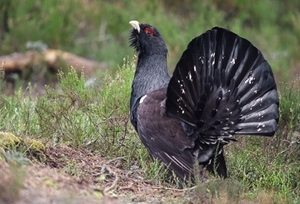Tetrao urogallus
 The Capercaillie is primarily associated with conifer woodlands in Scotland, especially mature Scots pine forests with an understory of heather, bilberry Vaccinium myrtillus and cowberry Vaccinium vitis-idaea.
The Capercaillie is primarily associated with conifer woodlands in Scotland, especially mature Scots pine forests with an understory of heather, bilberry Vaccinium myrtillus and cowberry Vaccinium vitis-idaea.
Originally restricted to Scotland, Ireland and northern England, the capercaillie became extinct there in the 18th century following extensive felling of pinewood habitats and a run of cold, wet summers in the 'Little Ice Age'. It was re-introduced into Scotland, by landowners with an interest in shooting, in the mid-19th century and spread to eastern and central Scotland. In recent years, numbers have decreased,
The reasons for the recent reductions in numbers and range are poorly understood, but may include habitat deterioration, increased predation, fence collisions and insect shortages in June causing poor chick survival. The Scottish population is only a small proportion of the world population, which is also declining over most of its range in association with losses of mature forest and human disturbance.
When they were more common, capercaillie were often shot either as trophies or on organised drives, but bags have never been large. Since the recent reduction in numbers there has been a voluntary moratorium by landowners on shooting. However, there is no sign that this has reversed the decline.